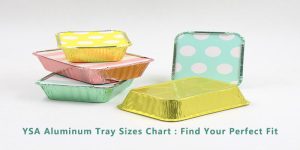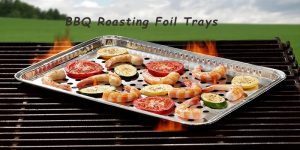Is Foil Pan Oven Safe
Most foil pans are oven-safe. The raw material of the aluminum foil tray is aluminum foil. Aluminum reacts well to heat and has high thermal conduction and heat resistance. The bottom or packaging of foil pans frequently has instructions that tell you whether the pan is oven-safe.
Foil containers can withstand temperatures of approximately 200 °C. Check aluminum foil pans before oven use – discard damaged or warped containers immediately for safe baking.
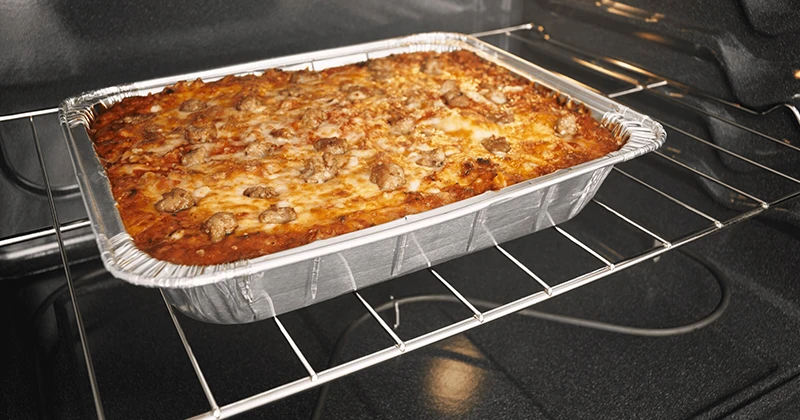
What is Foil Pan
foil tray, also called aluminum foil tray, is a disposable container made of aluminum. Compared with other materials, it is light-weight, has good barrier properties, is moisture-proof, and has a long shelf life. It can effectively maintain the freshness and moisture of food. Such as airline food, cake food retail, and packaging of barbecue, roast chicken and other food.
Aluminum foil pans are resistant to high temperatures and oils, and the oxide layer on the foil that is safe for human health.
For plastic foam lunch boxes, when the food temperature exceeds 65°C, the toxic substances contained in the container will seep into the food. Aluminum foil containers have no such shortcomings at all. They have stable performance, high temperature resistance, and are healthy to use.
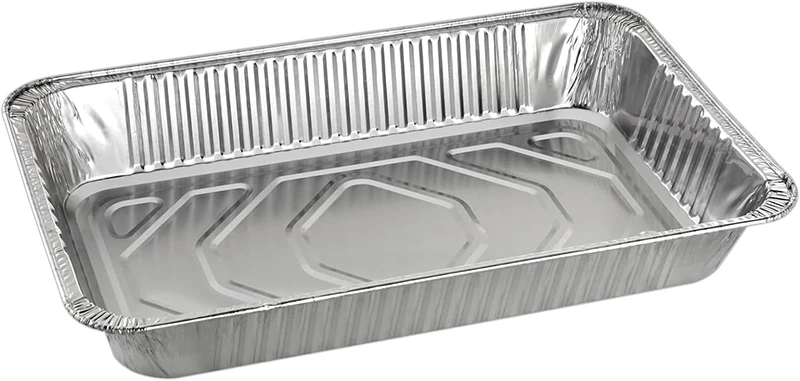
What Temperature Can Foil Pans Withstand?
Aluminum foil pans can typically withstand temperatures up to around 450°F (232°C).
- Standard foil pans are generally safe around 400-450°F (204-232°C); thinner foil pans may be lower.
- Heavy duty foil pans can withstand temperatures up to 500°F (260°C) or even higher.
- Foil pans lined with silicone or other heat-resistant coating can withstand temperatures up to 500°F (260°C) or higher.
When Can You Put Foil Containers in the Oven
Foil container can be placed directly in the oven. However, there are several aspects to note.
First, make sure that the high temperature reached by the oven is within the temperature tolerance range of the aluminum foil pan. Place the aluminum foil container on the grill to avoid deformation and cracking.
Secondly, do not put acidic food in the foil tray, as aluminum will easily precipitate. If you need to put acidic food, use food-grade debonding agent or food-grade paper to isolate it in the container. Finally, do not put the foil pan in the oven with the lid on to prevent the risk of injury.
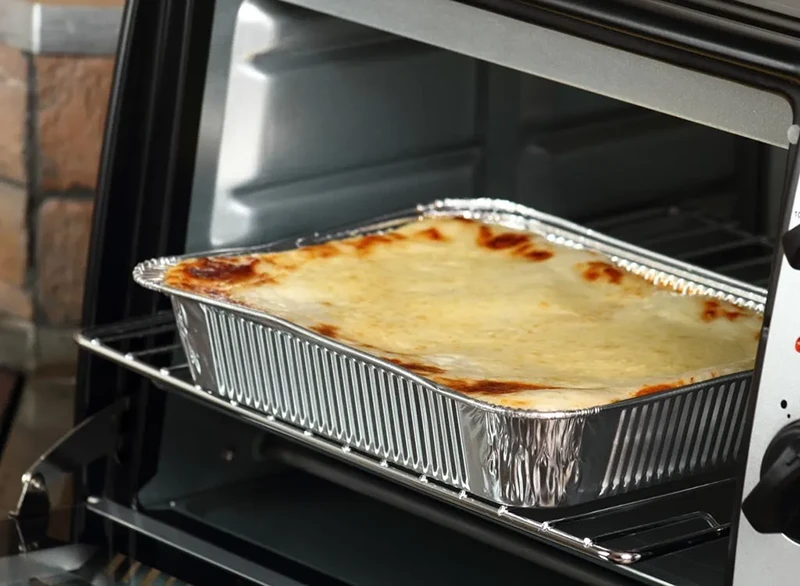
Precautions for Using Foil Pans Oven
- Choose the right pan: Choose oven-safe aluminum foil pan, a type that can withstand the heat of the oven without warping or melting.
- Avoid direct contact: Place foil pan in the center of the oven and make sure it does not direct contact with the heating element.
- Use oven mitts: Always use oven mitts or heat-resistant gloves when handling hot foil pans to prevent burns or injuries.
- Line the pan: When cooking highly acidic or spicy foods, line the pan with parchment paper or aluminum foil.
- Monitor cooking progress: Watch the cooking progress through the oven window instead of opening the oven door frequently.
- Proper disposal: When disposing of used aluminum foil pans, make sure they are clean and dry before recycling.
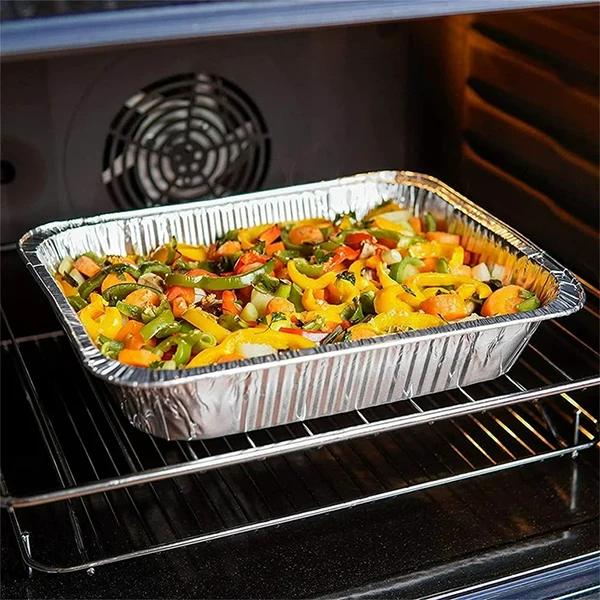
How to Identify Oven-Safe Aluminum Foil Pans
Check to see if the packaging of the foil pan is clearly marked “oven safe.” Read the instructions and recommendations and review the specifications and instructions to learn about its heat-resistant temperature range.
Moderate thickness and high-durability aluminum foil trays, can remain stable and not deformed at high temperatures. Pay attention to the thickness of the bottom and side walls, they need to be able to withstand the demands of high-temperature cooking.
Can Aluminum Foil in Toaster Oven
Yes, you can use aluminum foil in the oven, but you cannot use it as an oven lining. When using aluminum foil in the oven, make sure the foil does not block the vents or contact with heating element. And do not completely wrap food in the foil.
Foil is not oven lining. Because using foil paper in the oven may melt and damage the oven and other equipment.
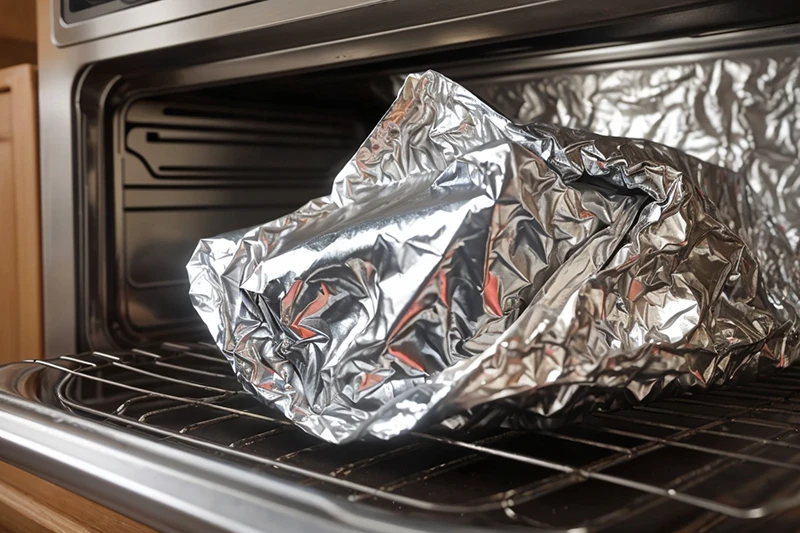
What to Use Instead of Tin Foil in Oven
- Parchment paper: Parchment paper is a great alternative for lining baking sheets or wrapping food in the oven. Non-stick, heat-resistant, and have a variety of baking and roasting applications.
- Silicone baking mats: Silicone baking mats are reusable, and also as a non-stick surface in the oven. They are durable and easy to clean.
- Oven-safe glass baking dish: A glass baking dish or casserole dish are alternative to aluminum foil for cooking. They are oven safe.
6 Things You Never Put in the Oven
Even if you cook every day, you will still find one or two things you don’t know in the kitchen every day. For example, can you put baking paper and wax paper in the oven?
When cooking in a high-temperature oven, if you are a little careless, it is likely to cause a fire or explosion. You should know that the following 6 things.
Wax paper, kitchen paper or other paper:
Baking paper is specially used for baking. It is non-stick and oil-resistant. When you run out of baking paper, never replace it with wax paper. Because wax paper will melt when heated in the oven, the paper will catch fire, which is dangerous.
Paper plates, paper boxes and kitchen paper with a layer of plastic or wax to prevent leakage. These items will catch fire when exposed to high temperatures.

Plastic containers:
Do not heat any plastic pan in the oven. Plastic containers for cold food are only for commercial use and are not suitable for cooking. After use, plastic will degrade and unreused.
I don’t recommend that plastic products expose to high temperatures and hot water. Because the plastic container will melt during high temperature heating, it will produce harmful substances and contaminate your food.

Glass containers:
Some people think that all glass containers put in the oven is safe. In fact, not all glass containers use the same material. Unless the glass dish has “oven safe” marks, don’t risk putting glass in the oven.
When using glass containers in the oven, be careful that the glass without cracked or broken, and it must have ingredients. Also, do not put frozen or refrigerated glass dishes directly into the oven, as they are prone to bursting.

Food residue:
When baking apple pie, if you overfill the pan, you will notice noises in the oven. You need to be aware that all foods, especially those containing grease or sugar, can easily catch fire in the oven. If ingredients fall to the bottom of the oven, they will burn, smoke, and in serious cases, catch fire.
When putting food in the oven, place metal baking tray underneath, lined with aluminum foil to prevent food from leaking. Before baking, carefully check the baking tray for any residue, and if so, remove it immediately.

Wet potholders or oven mitts:
Never use wet potholders or mitts to remove baking sheet from the oven, or you will hurt. If you take baking sheet out of a hot oven with wet gloves, the moisture on the gloves will turn into steam, which can easily cause burns.
To avoid burns, you need use silicone insulated oven mitts. These mitts are not only waterproof and heat-resistant, but also dishwasher-safe.

Do not put frozen food directly into oven:
Sometimes, to save time, some people put frozen food directly into the oven. But I suggest you follow the instructions on the package. Frozen chicken nuggets and pizza, you can put into the oven directly without thawing.
But frozen turkeys for Thanksgiving must defrost completely before putting into the oven. Or it will take a long time to bake the turkey and become insipid.



